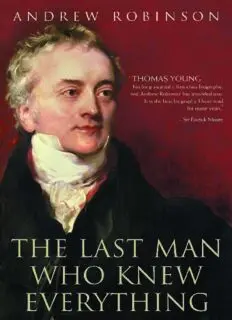
The Last Man Who Knew Everything: Thomas Young, the Anonymous Polymath Who Proved Newton Wrong, Explained How We See, Cured the Sick and Deciphered the Rosetta Stone PDF
Preview The Last Man Who Knew Everything: Thomas Young, the Anonymous Polymath Who Proved Newton Wrong, Explained How We See, Cured the Sick and Deciphered the Rosetta Stone
00i-14_Robinson_FM.qxd 7/4/06 11:37 AM Page i The Last Man Who Knew Everything 00i-14_Robinson_FM.qxd 7/4/06 11:37 AM Page ii Portrait ofThomas Young in the 1820s.The engraving is based on the portrait painting in color by Sir Thomas Lawrence reproduced on the dust jacket. 00i-14_Robinson_FM.qxd 7/4/06 11:37 AM Page iii The Last Man Who Knew Everything Thomas Young, The Anonymous Polymath Who Proved Newton Wrong, Explained How We See, Cured the Sick, and Deciphered the Rosetta Stone, Among Other Feats of Genius Andrew Robinson 00i-14_Robinson_FM.qxd 7/4/06 11:37 AM Page iv The Last Man Who Knew Everything AOneworld Book First published in the USAby Pi Press New York 2006 First published in Great Britain by Oneworld Publications 2006 Copyright ©2006 by Pearson Education, Inc. Published by arrangement with Dutton, a member of Penguin Group (USA) Inc. All rights reserved Copyright under Berne Convention ACIPrecord for this title is available from the British Library ISBN-13:978-1-85168-494-6 ISBN-10:1-85168-494-8 Typeset by EXPO Cover design by eDigital Design Printed and bound in India for Imprint Digital Oneworld Publications 185 Banbury Road Oxford OX2 7AR England www.oneworld-publications.com NL08 00i-14_Robinson_FM.qxd 7/4/06 11:37 AM Page v FOR DIPLI, “CON AMORE” 00i-14_Robinson_FM.qxd 7/4/06 11:37 AM Page vi 00i-14_Robinson_FM.qxd 7/4/06 11:37 AM Page vii Contents Preface ix Introduction 1 1 Child Prodigy 15 2 Fellow of the Royal Society 33 3 Itinerant Medical Student 41 4 ‘Phenomenon’Young 55 5 Physician ofVision 67 6 Royal Institution Lecturer 85 7 Let There Be Light Waves 95 8 ‘Natural Philosophy and the Mechanical Arts’ 113 9 Dr Thomas Young,M.D.,F.R.C.P. 131 10 Reading the Rosetta Stone 143 11 Waves of Enlightenment 165 12 Walking Encyclopedia 179 13 In the Public Interest 189 14 Grand Tour 201 00i-14_Robinson_FM.qxd 7/4/06 11:37 AM Page viii viii The Last Man Who Knew Everything 15 Dueling with Champollion 209 16 A Universal Man 223 Notes and References 241 Bibliography 265 Index 273 00i-14_Robinson_FM.qxd 7/4/06 11:37 AM Page ix Preface Versatile people have always fascinated me as a biographer. Most recently, there was Albert Einstein, who, as everyone knows, fathered diverse new fields of science, but who also influenced some crucial areas of international politics. Before Einstein, Michael Ventris,a professional architect who in his spare time deciphered Linear B, the earliest European writing system, and became revered by archaeolo- gists.And before Ventris,two prodigious Indians,the writer Rabindranath Tagore and the filmmaker Satyajit Ray,both of whom were intensely cre- ative in areas outside literature and cinema. But I must admit that Thomas Young (1773-1829),for sheer range of expertise,beats them all.Not only did he make pioneering contributions to physics (the wave theory of light) and engineering (the modulus of elasticity),to physiology (the mechanism ofvision) and to Egyptology (the decipherment of the hieroglyphs),but he was also a distinguished physi- cian, a major scholar of ancient Greek, a phenomenal linguist, and an authoritative writer on all manner of other subjects,from carpentry and music to life insurance and ocean tides. In an exhibition on Young arranged by London’s Science Museum for his bicentenary in 1973, the organizers went so far as to state:“Young probably had a wider range of creative learning than any other Englishman in history.He made discover- ies in nearly every field he studied”. This makes Young a tough subject for a biographer,and perhaps that is why there has not been a new biography of him for half a century.I have contemplated writing one for over a decade,since first encountering Young while researching a book,The Story ofWriting,and I became further com- mitted to the idea while writing another book,Lost Languages,on archaeo- logical decipherment, a few years later. But having thought about the challenge,I decided it would be better to write an introduction to Young for a new audience,rather than attempting a full biography.To cover his
